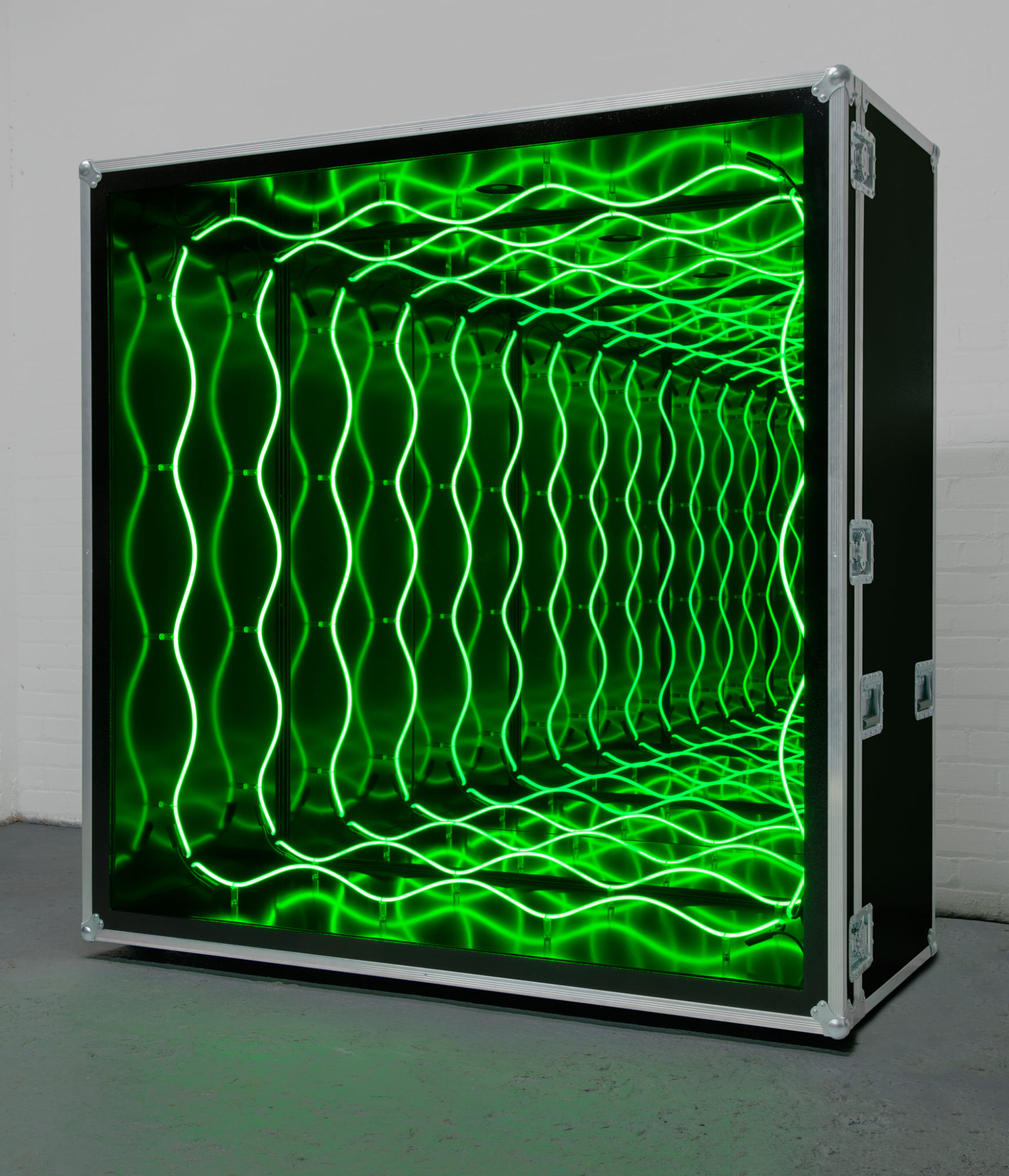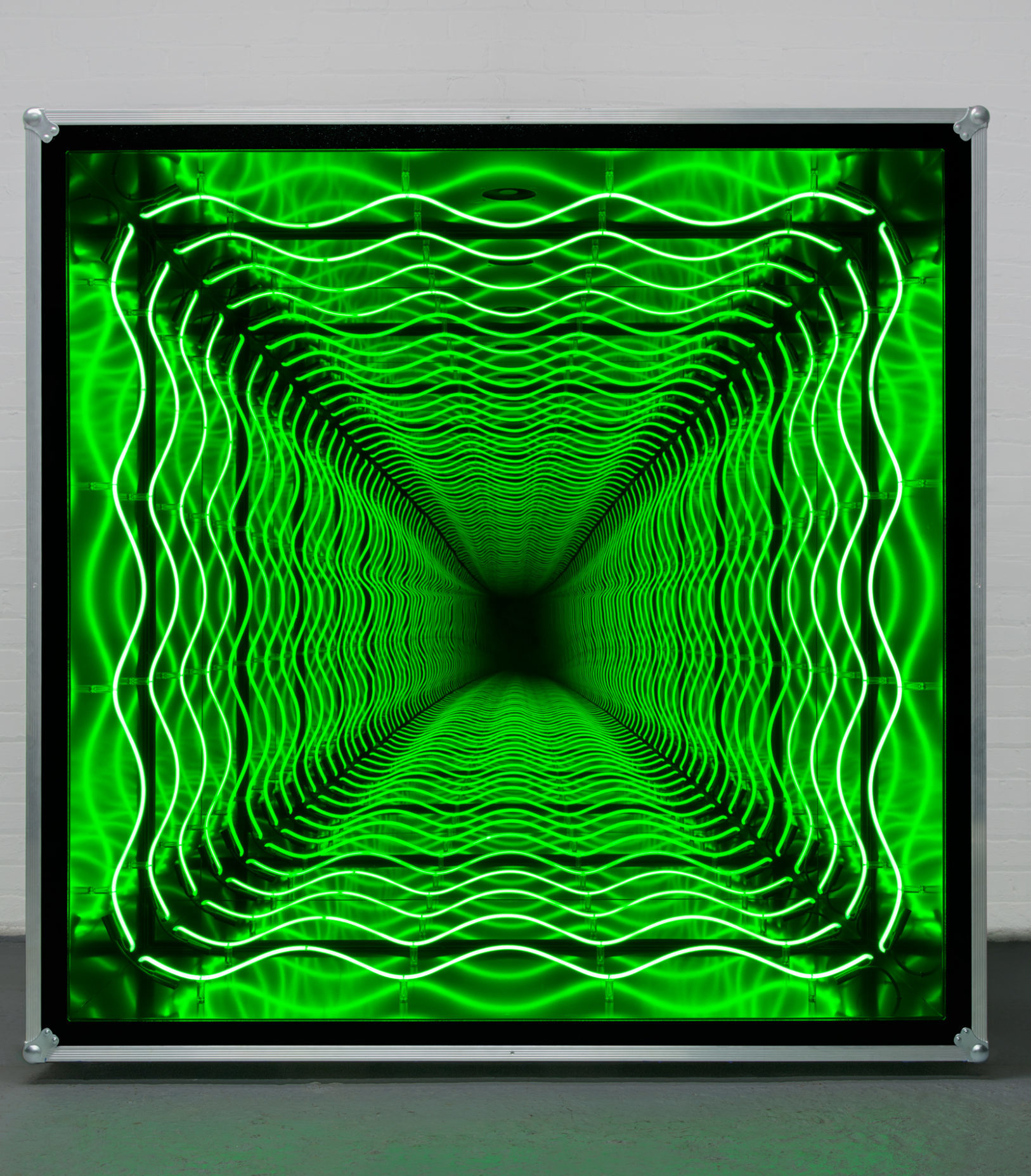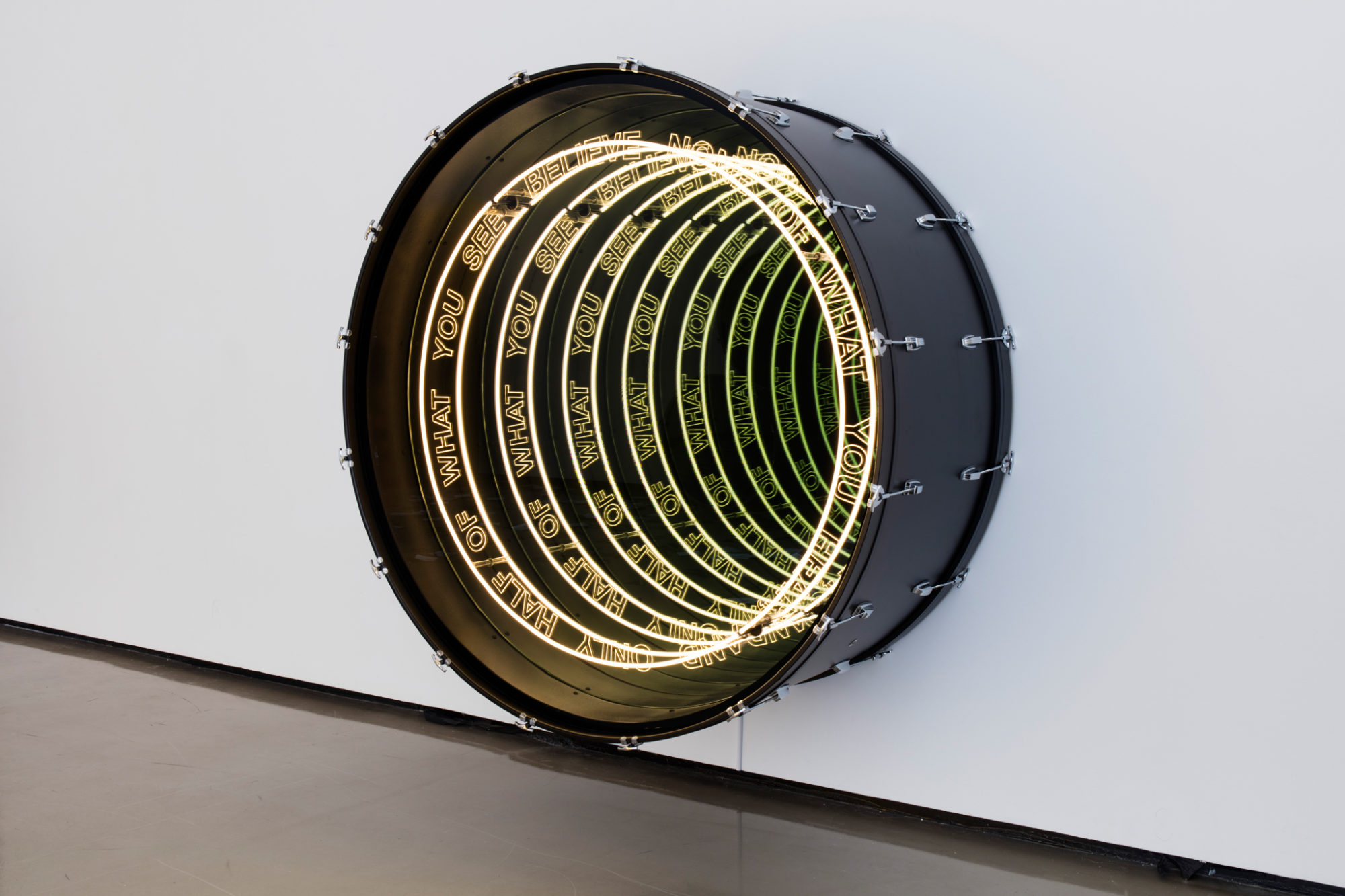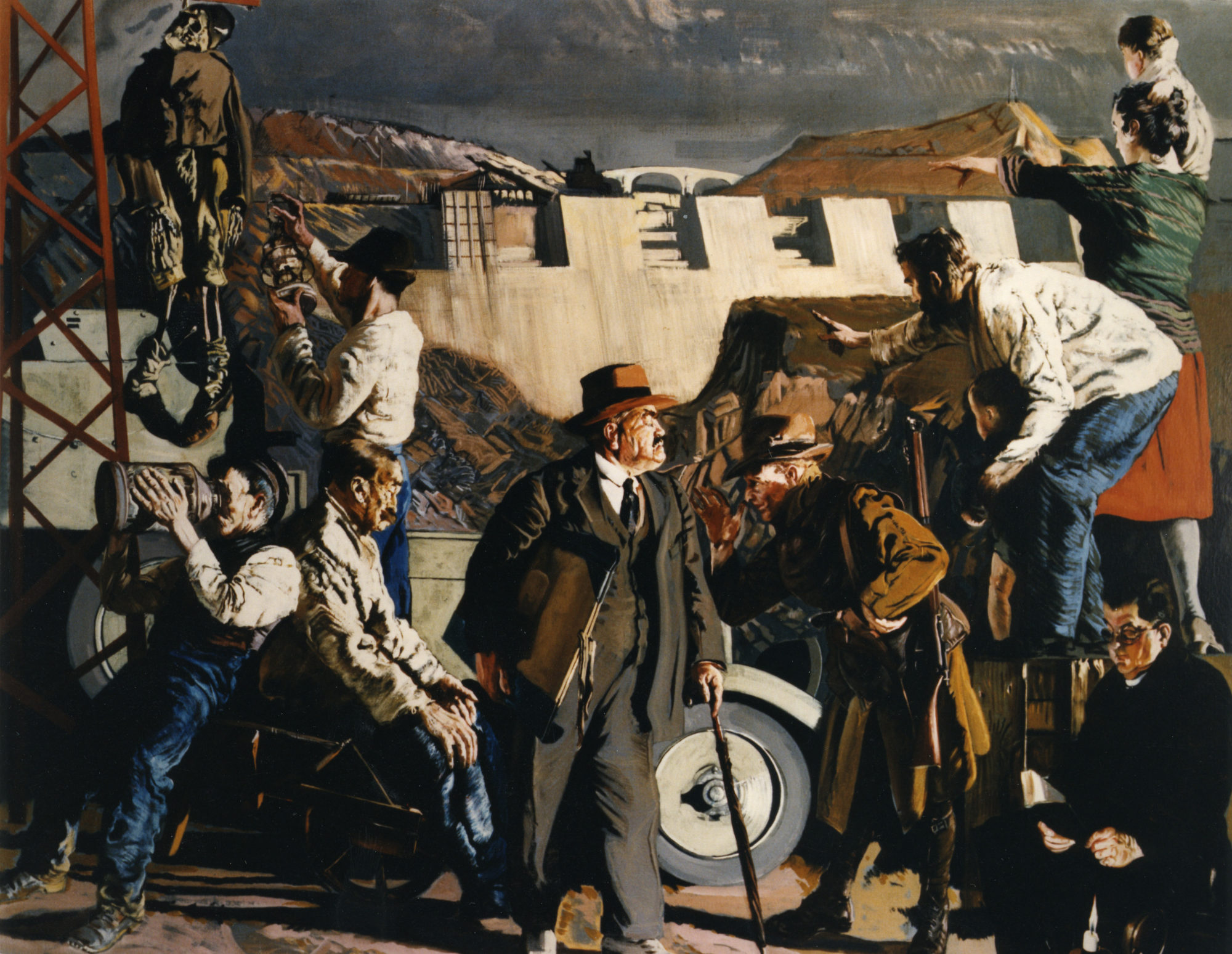A Brief History of Power
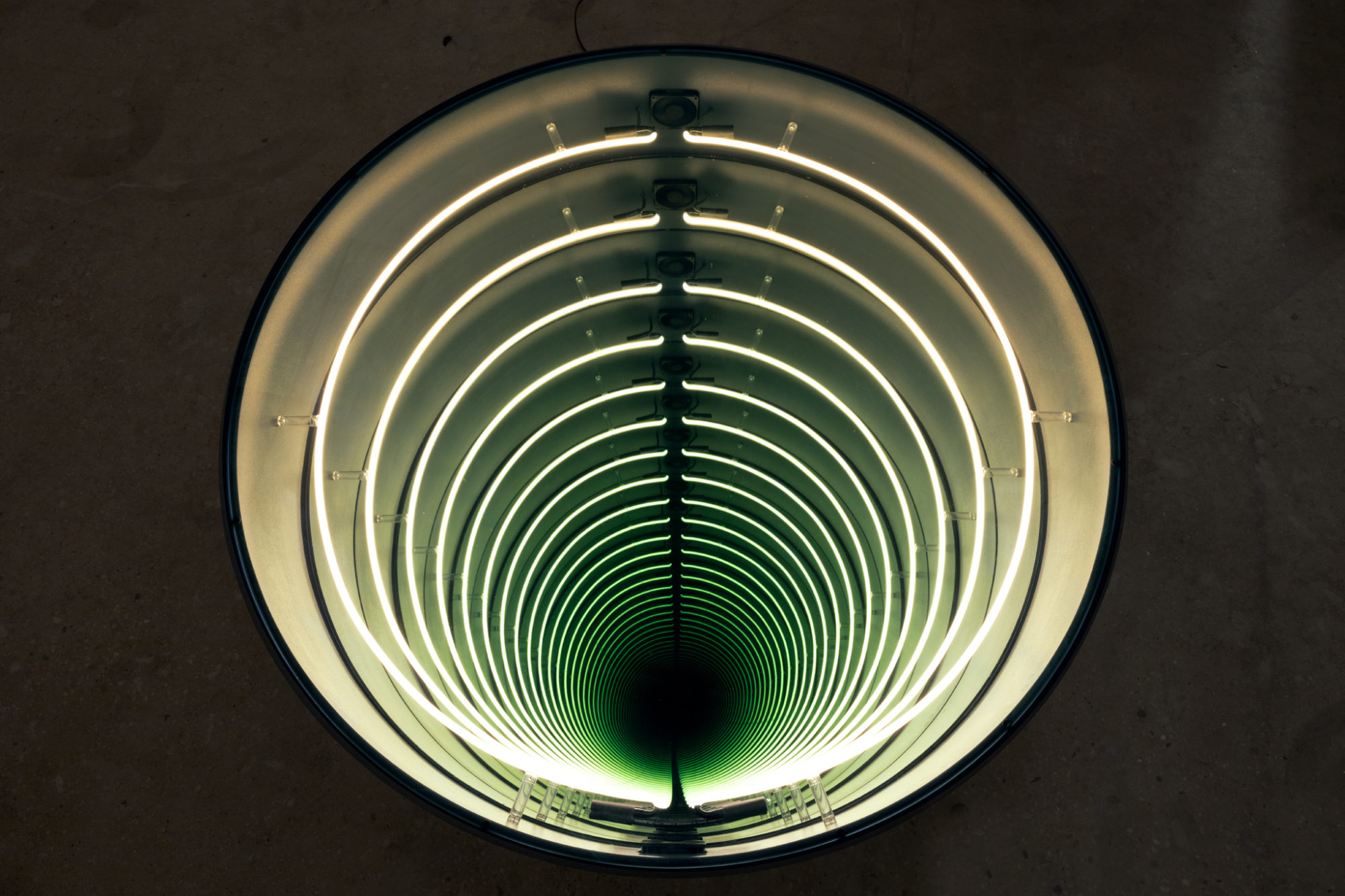
Ivan Navarro, Duct, 2016, neon light, plywood, glass, mirror, one-way mirror and electric current, 12 x 48 x 48 inches [photo: Christopher Stach; courtesy of the artist and Kasmin Gallery, New York]
Share:
“The tentacles of electrification can be regarded as a central element of ‘modernity at large’…”—Tanja Winther and Harold Wilhite1
Power in one of its most literal forms—electricity—is both material and metaphor in the work of Chilean artist Iván Navarro, for good reason. The history of electricity is tied to that of modernity, and its necessity to modern life has created a potent form of statecraft, through which populations have been connected and/or controlled via access (or lack thereof) to the energy grid. Dominic Boyer has described this influence as “energopolitics”—a theory that “power over (and through) energy” has been “the companion and collaborator of modern power over life and population from the beginning.”2
Navarro’s work speaks to these politics—not only a reaction to his experience of growing up under the Pinochet regime, which used electricity as an instrument of torture, but also an interrogation of the US government’s engagement in Chilean politics at the time, and a response to capitalism’s pervasive power.3 Pinochet led a military coup against Marxist president Salvador Allende in 1973, an event seen as a victory for free-market capitalism against state-centred socialism during the Cold War era. The 17-year dictatorship that followed brought neoliberalization of the Chilean economy, as influenced by the so-called Chicago Boys, with Pinochet overturning Allende’s policies of nationalization that were implemented following his 1970 election, which effectively ousted US business from Chile and triggered what Allende described in 1972 as an “invisible financial and economic blockade.”4
Chile’s electricity reforms throughout the 1970s and 1980s led to large-scale privatization of the sector5 and were considered “a model for other privatisations” around the world.6 “By the late-1990s,” Michael Pollitt writes, “foreign firms had gained majority ownership of the Chilean electricity system.”7
Ivan Navarro, Impenetrable Room, 2016, neon, aluminum, mirror, on-way mirror and electric energy, 72 x 72 x 30 inches [photo: Christopher Stach; courtesy of the artist and Kasmin Gallery, New York]
Ivan Navarro, Impenetrable Room, 2016, neon, aluminum, mirror, on-way mirror and electric energy, 72 x 72 x 30 inches [photo: Christopher Stach; courtesy of the artist and Kasmin Gallery, New York]
Around the late 1990s, Navarro moved to the United States. He began to draw together his home and host contexts in sculptures that play with minimalism as “the art of the Cold War” and a representation of US power.8 You Sit, You Die (2002), for instance, resembles a classic garden deckchair—its frame is constructed out of fluorescent light tubes, with a fabric sling replaced by a paper scroll listing every person executed in Florida by electric chair until the time of the sculpture’s making. The work aligns the torture of an openly dictatorial regime with the state-sanctioned punishment of a democratic state, and seems to illustrate Navarro’s point that “American Minimalism obscured its politics,” whereas “in Latin America, that aesthetic was used to communicate political ideas.”9
The energy sector in Chile likewise communicates both obscure and transparent political dynamics through its formal structures. In recent years there have been calls for regulatory reform to the sector, despite the apparent success of Chile’s neoliberal transformation; the HidroAysén plan to construct five hydroelectric dams in Patagonia is a good example of this shift. The plan was first proposed by what was then a state enterprise, Endesa Chile, in the 1970s. By the time the project was reproposed in 2006 and approved in 2011, Endesa was a Spanish-owned subsidiary of Enel, an Italian multinational energy company working in 34 countries across five continents.10 The plan triggered protests surrounding the megaproject’s environmental impact and disregard of local sustainability for the sake of international profit. The government rejected plans in 2014,11 the year center- left president Michelle Bachelet returned to power, after her first term was followed by the election of conservative Sebastián Piñera—the first time Chileans voted a right-winger into power since the end of the dictatorship in 1990—who then replaced Bachelet again in the 2017 presidential election.12 Yet, despite such political oscillations, sustainable and renewable energy has become a common political cause.13 In 2017, HidroAysén S.A. officially dissolved and its water rights returned to the state.14
Ivan Navarro, Benjamin Franklin, 2016, neon, LED lights, aluminum, drum, mirror, one-way mirror, and electric energy, 60 x 60 x 28 1/4 inches [photo: Christopher Stach; courtesy of the artist and Kasmin Gallery, New York]
Notably, Manuel Tironi and Javiera Barandiarán point out that the protests against the HidroAysén project expressed the same accusations of corruption leveled at Endesa when it was a public entity in the 1970s—an example of neoliberalism’s ability “to respond to new challenges, such as demands for greater participation from the state,” which goes against the supposed neoliberal idea of eliminating or reducing state control over the market.15 In 2016, for example, the Chilean government passed an electricity transmission law establishing an interconnected national power system under the aegis of the then-newly formed CEN, to consolidate the energy sector into a more efficient, sustainable, environmentally conscious system.16 Such developments feed into Tironi and Barandiarán’s reading of neoliberalism as a political technology that should “be understood as a set of techniques that transform users and techniques, just as it is transformed by them.”17
Tironi and Barandiarán’s observation recalls Pierangelo Toninelli’s paper summarizing the “rise and fall of state-owned enterprise (SOE) in the Western world,” which itself describes a cycle: “From private to public to private again.” In his conclusion, Toninelli refers to economist Arnold Heertje, “who reminds us that history has always been characterized by the continuous alternation between phases of extreme state activity and reactions in the opposite direction.”18 This cycle seems embedded into the processes of recent history—through the antagonism between the political Right and Left—in which ongoing and shifting relations transform both sides.19
The 38th EVA International, a biennial exhibition staged in the Irish city of Limerick, explored similar dynamics. Curated by Inti Guerrero, the show examined the interconnections between Ireland’s electrification and its postcolonial independence. In her catalogue essay for the exhibition, Sorcha O’Brien describes Ireland’s centralized electricity grid and its relationship to modern statecraft and nationhood with the terms “essentialism” (identity built through culture, tradition, and history) and “epochalism” (a forward-looking engagement with science, technology, and modernity).20 For anthropologist Clifford Geertz, “these two ideas … swing back and forth at different times, depending on cultural, economic or political factors … and are amenable to change.”21 The interrelation between these two concepts aptly describes the current negotiation between histories of nationalism and globalization—both of which are embodied in the history of Ireland’s electrification, as encapsulated in a 1927 painting by Seán Keating, Night’s Candles are Burnt Out, which Guerrero positioned as an anchor to his EVA exhibition. Night’s Candles are Burnt Out is an allegorical work capturing the construction of the Ardnacrusha dam and hydroelectric power plant on the River Shannon, whose construction commenced after a devastating civil war that followed the Irish War of Independence.
Sean Keating, “Night’s Candles Are Burnt Out,” 1928-29, oil on canvas, 40.5 x 50 inches [courtesy of Gallery Oldham]
The Ardnacrusha project was part of the Shannon Hydroelectric Scheme, developed between 1925 and 1929, with a national electricity grid built in tandem.22 The Shannon Scheme was one of the largest civil and electrical engineering projects of its day23—effectively a declaration of self-sufficient autonomy by the newly established Irish Free State, which lacked natural deposits of coal, and had existed with little electric power until that time.24 It also represented one of the first integrated national electricity systems in the world and served as a “model for large-scale electrification schemes worldwide.”25 The Shannon Scheme was followed by the Rural Electrification Scheme in the late 1940s, which led to the electrification of the entire state.26 In the United Kingdom, Prime Minister Stanley Baldwin established a national grid in 1926 by connecting 122 power stations in the country through the Electricity Supply Act27—“a system that linked the population together more intimately than ever before.”28
Keating’s painting captures the magnitude of the Shannon Scheme and its impact. It shows the Ardnacrusha construction site in the background, framed by characters symbolizing archetypes of Irish society: workmen, hanging skeletons (symbols, Keating explained, of the stereotypical “stage Ireland and the stage Irishman”29 ), a mother and child looking toward the dam, and a priest reading in a corner. At the center, a capitalist holding industrial plans faces off with a gunman—two figures, Keating noted, that “symbolize the constant antagonism between the business elements and the extremists, which hinders the material progress of the State.”30 This central opposition expresses “the transition of Ireland from a country of ancient stagnation to a state of freedom and progress”—“a metaphor,” as Eimear O’Connor notes, “for [Keating’s] vision of a light-filled and enlightened future for post-independent Ireland, wrought and shaped from … the unenlightened colonial past.”31
The transition Keating envisioned happened. The year Night’s Candles was painted, the Electricity Supply Board (ESB), the world’s first such semi-state body, was established to operate Ardnacrusha under the Electricity Act.32 Today, the ESB—a 95%–government-owned statutory corporation33—manages “11 thermal stations, 19 wind farms and 10 hydro stations in Ireland and the UK,” with Ardnacrusha representing a mere 2% of its installed capacity.34 Meanwhile, Ireland has become a 21st-century global tech hub—a result of the efforts of IDA Ireland (formerly known as the Industrial Development Authority), which successfully brought Google to Dublin’s Grand Canal Dock in 2003, since dubbed “Silicon Docks”; Facebook, Twitter, TripAdvisor, and many others followed.35
Ireland’s century of electric development is a global story, tied to the ongoing and global history of electrification, not to mention the development of the nation-state and the emergence of a conflicted present, in which the processes of nationalism and globalization are engaged in active and open opposition.
Ivan Navarro, Tuning, 2015, LED lights, drums, mirrors, one-way mirrors, and electric energy, 102 x 111 1/2 x 23 inches [photo: Christopher Stach; courtesy of the artist and Kasmin Gallery, New York]
Consider Jeff Bezos’ comparison of the dot-com revolution to the early days of electricity, which he yokes to the light bulb: “The killer app” that “wired the world” and prepared it for electrical appliances by laying “down the heavy infrastructure” necessary to transmit electric power.36 In his comparison Bezos cited the construction of the Pearl Street power station in Lower Manhattan by Thomas Edison: a major experiment at producing an electricity grid, which required the installation of an underground network incorporating almost 100,000 feet of wiring and conduits that connected to 3,000 incandescent lamps.37 The plant commenced operations in September 1882, marking the birth of “the modern utility industry.”38 What followed was a development that has been compared to that of the railroad. This analogy rings true when considering the context of the late 19th-century—a time when, quoting professors William J. Hausman, Peter Hertner, and Mira Wilkins jointly, “Steamships and cables linked distant continents,” “Railroads and telegraph lines stretched into interiors of independent as well as colonized countries,” “Ideas, knowledge, and technology could (and did) circulate through individuals, companies, and imperial administrators,” and “Capital was more mobile than ever.”39 In fact, “Many of the banks and financial intermediaries that took part in financing electric utilities gained their initial experience in international transactions in railroad finance.”40 The electricity market was booming. A collection of multinational corporations aligned themselves with imperial Western powers—including Germany, France, Switzerland, Belgium and the United Kingdom—and invested in public utilities across Europe, the Americas, and Asia.
Against this multinational backdrop—essentially an expansion of colonial pursuits abroad, “in December 1920, electrical engineer and Bolshevik Gleb M. Krzhizhanovskii displayed an illuminated map of a future electrified Russia to convince the 8th Congress of Soviets to approve a plan for state electrification.”41 At the time, “Moscow’s generating capacity was so low … that lighting the bulbs on the map resulted in blacking out parts of the city,”42 and before the Russian Revolution, some “90 percent of the light and power produced in Russia came from facilities of foreign companies.”43
While Russia attempted to nationalize electricity in the early 20th century, the United States and Europe pursued expansionist dreams. In 1930, for example, Dannie Heineman and Oscar Oliven proposed a connecting grid that would rationalize electric utilities throughout Europe.44 Many Western powers, particularly the United States, benefitted from the German defeat in World War I, as it left Germany’s international operations open for acquisition.45 At the time economist Frank Southard observed the increasing stakes American corporations held in the electrical industry,46 with American & Foreign Power—set up by Electric Bond & Share in 1924 to “serve as a vehicle for further foreign expansion”47—emerging as the largest multinational enterprise in public utilities” to provide “light and power to some 755 communities in Latin America and Asia,” Chile included.48 As economics professors William J. Hausman and John L. Neufeld write, “foreign investment in electric utilities comprised the largest single component of U.S. foreign direct investment in the last half of the 1920s.”49
This electric boom would come to a head after World War II, when former colonies considered electrification and industrialization a national affair, recalling Lenin’s December 1920 proclamation that victory would be attainable “Only when the country has been electrified ….”50 In Soviet Russia, electrification and political power went hand in hand. “Communism is Soviet power plus the electrification of the whole country. ,” Lenin famously said in his December 1920 speech.51 Yet, with slight modifications, this equation could work with nationalism, international imperialism, and global capitalism, too, as power—be it electrical or human—is effectively generated, maintained, and asserted through the consolidation of energy into a grid, network, or collective. As one doctor from Northern Syria noted in a 2016 Amnesty International Report, “Hospitals, water and electricity are always the first to be attacked” in a war, because “Once that happens people no longer have services to [help them] survive.”52 This quote appears in an article about Monuments of the Everyday, a project by the collective Sigil (architects Khaled Malas and Salim al-Kadi, graphic designer Jana Traboulsi, and visual artist Alfred Tarazi), which has endeavoured to build windmills and wells in Syria since 2014, amid the civil war there—structures they describe as “humble architectures of resistance” that the collective funds by presenting the project as an artistic one.53
Ivan Navarro, Duct, 2016, neon light, plywood, glass, mirror, one-way mirror and electric current, 12 x 48 x 48 inches [photo: Christopher Stach; courtesy of the artist and Kasmin Gallery, New York]
Ivan Navarro, Duct, 2016, neon light, plywood, glass, mirror, one-way mirror and electric current, 12 x 48 x 48 inches [photo: Christopher Stach; courtesy of the artist and Kasmin Gallery, New York]
An iteration of Monuments of the Everyday was shown in 2017 at Beirut’s Sursock Museum as part of Fruit of Sleep, a group show curated by Reem Fadda for the second act of Sharjah Biennial 13. A circular installation of glass vessels linked by copper and aluminium plates powering a small bulb stood in for a windmill that the collective built in a Damascus suburb in 2015. The actual windmill powered an underground hospital before a 2017 air raid destroyed it. Alongside the sculpture was Current Power in Syria, a publication that charted the history of electricity as a nation-building device through four stories spanning a century, including an account of a tram strike responding to fare hikes by the Belgian electrical utility company operating the trams and street lamps in Damascus, leading to the signing of the Franco-Syrian Treaty of Friendship; and the making of The Film-Essay on the Euphrates Dam (1970) by Syrian filmmaker Omar Amiralay, a propaganda film about the largest development project in the history of Syria, which Amiralay later regretted making.54
Khaled Malas likens electricity to an “invisible force that manifests itself … through practitioners or infrastructure or appliances”55—a view that aligns with the description of power put forward by legal scholars Alan Hunt and Gary Wickham: “Power,” they write, is not only the “technical process by which coal, water, or nuclear fission fuels an incomplete (imperfect) energy grid to (imperfectly) drive any number of electrical appliances”—incomplete and imperfect because appliances, like people, “are not expected to operate perpetually in exactly the same way.”56 Power is the technical process that produces all aspects of social life and governance, plus the techniques that constitute the process.57
All of which returns us to the dialectical play between such oppositions as private and public, communist and capitalist, national or global—the antagonisms inscribed into the material manifestations of power itself. Hunt and Wickham’s definition denies the notion that power is “negative” or “conspiratorial,” and it accepts the fact that challenges are not only inevitable but an inherent part of any technique of governance.58 In short, they write, power is the process of keeping things going, and it responds to the resistance that it produces—a cycle of contestation that creates the politics that have not only historically electrified the modern world but also continue to define it.
This feature originally appeared in ART PAPERS “Energy Structures” Spring/Summer 2019.
Stephanie Bailey is editor in chief of Ocula magazine, a contributing editor at ART PAPERS and LEAP, and a regular contributor to Artforum International, Yishu: Journal of Contemporary Chinese Art, and dɪ’van: A Journal of Accounts. Formerly the senior editor of Ibraaz, where she worked from 2012 to 2017, Bailey is also a member of the Naked Punch editorial committee; a managing editor of Podium, the online journal for M+ in Hong Kong; and the current curator of Art Basel Conversations in Hong Kong.
References
| ↑1 | Tanja Winther and Harold Wilhite, “The Tentacles of Modernity: Why Electricity Needs Anthropology,” Cultural Anthropology 30, issue 4 (November 2015), 570. |
|---|---|
| ↑2 | Dominic Boyer, “Energopolitics and the Anthropology of Energy,” Anthropology News 52, issue 5, (May 2011), 5. |
| ↑3 | “Iván Navarro in Conversation,” Ocula Magazine, May 11, 2018, web. |
| ↑4 | 4 See Paul E. Sigmund, “The ‘Invisible Blockade’ and the Overthrow of Allende,” Foreign Affairs 52, No. 2 (January 1974), 322–340. |
| ↑5 | Michael Pollitt, “Electricity Reform in Chile: Lessons for Developing Countries,” (September 2004). Paper prepared as part of the research program on Industrial Organization Policy for Development at the Development Research Group of the World Bank. |
| ↑6, ↑7, ↑9, ↑42, ↑51, ↑53, ↑55, ↑57 | Ibid. |
| ↑8 | As stated in conversation with Cynthia Garcia, “Light Producer: Iván Navarro and the Politics of Art,” New City Brazil, August 7, 2018, web. |
| ↑10 | Eden Medina, Ivan da Costa Marques, and Christina Holmes (Cambridge, Massachusetts: MIT Press, 2014), 317. See also ENEL, “About Us,” web. |
| ↑11 | See Brian Clark Howard, “Chile Scraps Huge Patagonia Dam Project After Years of Controversy,” National Geographic, June 10, 2014, web. |
| ↑12 | Ernesto Londoño, “In Chile, a Billionaire Takes the Reins From a Socialist, Again,” New York Times, March 18, 2018, web. |
| ↑13 | Most recently, Piñera voiced a commitment to sustainable development during the launch of the United Nations Framework Convention’s COP25 climate change summit, which will take place in Chile in December 2019. See “President Sebastián Piñera and Minister Carolina Schmidt launch COP25 climate change summit,” UNFCCC website, April 11, 2019, web. |
| ↑14 | See Herman Chadwick Piñera, “Letter from the Chairman,” in Annual Report: Enel Chile 2017, 5, web. |
| ↑15 | Tironi and Barandiarán, 323. |
| ↑16 | See “Chile’s Transmission Proposals: RE drives investment in the grid,” Global Transmission Report, March 12, 2018, web. |
| ↑17 | Tironi and Barandiarán, 308. |
| ↑18 | Pierangelo Toninelli, “From private to public to private again,” Análise Social XLIII, 4.º (2008), 690. |
| ↑19 | “Iván Navarro in Conversation,” Ocula Magazine, May 11, 2018, web. |
| ↑20 | Sorcha O’Brien, “You Don’t Know What You’ve Got ’Til It’s Gone: Infrastructure, National Identity, Technology, and Modernity,” 38th EVA International catalogue (2018), 46. |
| ↑21 | O’Brien, 46. |
| ↑22 | Ardnacrusha Generating Station information booklet, 3. See https://www.esb.ie/docs/default-source/education-hub/ardnacrusha-power-station |
| ↑23, ↑24 | Ardnacrusha Generating Station information booklet, 3. |
| ↑25 | Ardnacrusha Generating Station information booklet, 4. See also: Mary Mulvihill, Ingenious Ireland: A County-by-County Exploration of the Mysteries and Marvels (Dublin: Townhouse, 2002), 341. In 2002, the Shannon Scheme got standing equal to the Eiffel Tower’s when it received the Landmark Award, and its contribution to electrification was recognized with the Milestone Award, a prize won previously by Japan’s bullet train |
| ↑26 | See Aidan Dunne, “Metaphors of power: Infrastructure, cultural identity and the Irish State,” The Irish Times, April 7, 2018, web. |
| ↑27 | Gaby Hornsby, “The Secret Life of the National Grid,” bbc.com, October 26, 2010, web. |
| ↑28 | Hornsby, “The Secret Life of the National Grid.” |
| ↑29 | As quoted by Eimear O’Connor, in “Seán Keating and the Art of Nation Building,” a paper delivered at the conference Art and Reality: The Role of Visual Culture in the post-independent state, which took place October 19, 2018, at the UCD Humanities Institute as a joint initiative between the UCD School of Art History and Cultural Policy and the National Irish Visual Arts Library. For the podcast, see https://soundcloud.com/real-smart-media/eimear-o-connor-sean-keating-and-the-art-of-nation-building |
| ↑30 | As quoted by Eimear O’Connor. |
| ↑31 | Eimear O’Connor, in “Seán Keating and the Art of Nation Building.” |
| ↑32 | Mary Mulvihill, 341. |
| ↑33 | See “About ESB,” https://www.esb.ie/who-we-are/about-esb |
| ↑34 | Ardnacrusha Generating Station information booklet, 1. |
| ↑35 | See: Jj Worrall, “A seismic shift for Dublin: how Google was persuaded to set up shop in Ireland,” Irish Times, January 22, 2015, web. |
| ↑36 | Jeff Bezos, “The electricity metaphor for the web’s future,” TED Talks, recorded February 2, 2003. Transcript available at https://www.ted.com/talks/jeff_bezos_on_the_next_web_innovation/transcript |
| ↑37 | Jasmin K. Williams, “Edison Lights the City,” November 13, 2008, web. |
| ↑38 | Williams, “Edison Lights the City.” |
| ↑39 | William J. Hausman, Peter Hertner, and Mira Wilkins, Global Electrification, Multinational Enterprise and International Finance in the History of Light and Power, 1878–2007 (Cambridge University Press: Cambridge, 2008), 35. |
| ↑40 | Hausman, Hertner, and Wilkins, 63. |
| ↑41 | Coopersmith, The Electrification of Russia, 1880–1926 (Cornell University Press: Ithaca, 1992), 1. |
| ↑43 | Hausman, Hertner, and Wilkins, 118. |
| ↑44 | Hausman, Hertner, and Wilkins, 194. |
| ↑45 | Hausman, Hertner, and Wilkins, 132 |
| ↑46 | Hausman, Hertner, and Wilkins, 170. |
| ↑47 | William J. Hausman and John L. Neufeld, “The Rise and Fall of the American & Foreign Power Company: A Lesson from the Past?” The Electricity Journal 10, no. 1 (January/February 1997), 49. |
| ↑48 | Hausman, Hertner and Wilkins, 186. |
| ↑49 | William J. Hausman and John L. Neufeld, 46. |
| ↑50 | Vladimir Lenin, Report on the Work of the Council of People’s Commissars, December 22, 1920, viewed on: Seventeen Moments in Soviet History, An Online Archive of Primary Sources, web. |
| ↑52 | Nicholas Korody, “A well, a windmill, a mirror: Sigil’s real and symbolic interventions in Syria” (an introduction and interview with Sigil), Archinect, September 27, 2016, web. |
| ↑54 | As described by Khaled Malas in “A well, a windmill, a mirror: Sigil’s real and symbolic interventions in Syria,” Archinect. |
| ↑56 | Alan Hunt and Gary Wickham, Foucault and Law: Towards a Sociology of Law as Governance (Pluto Press: London, 1994), 81. |
| ↑58 | Alan Hunt and Gary Wickham, 82–83. |
